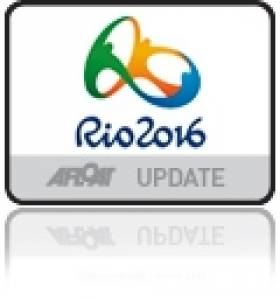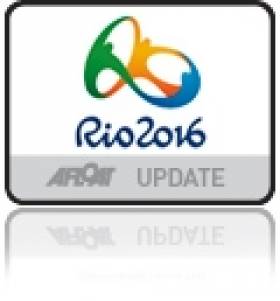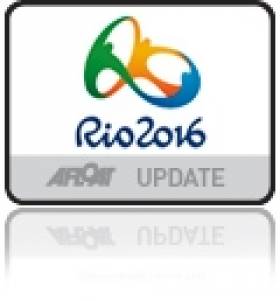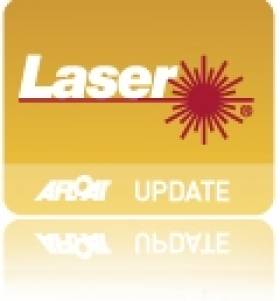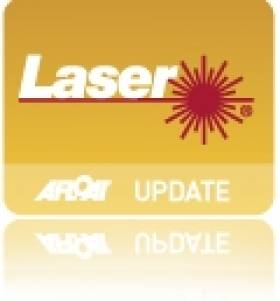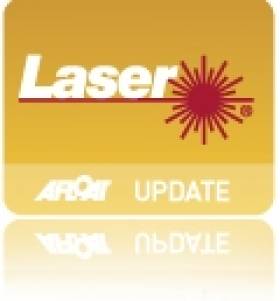Displaying items by tag: Laser
#LaserEuros2013 – Annalise Murphy goes into the final races of the Laser European and World Championships tomorrow on her native Dublin Bay with a comprehensive 17 point lead ahead of Holland's Olympic silver medallist Marit Bowmeester.
With the prospect of a breezy finale on the waters off Dun Laoghaire Murphy is looking to resume the same kind of form which has led to seven wins from her nine starts here and convert her big lead to her first major Laser Radial title. A disappointing 27th in today's light breezes is her discardable result.
In contrast the contest for the titles and trophies in the Olympic men's fleet is very delicately poised after two tricky races in light and unpredictable northerly winds today which made consistency very elusive. Indeed of the top ten sailors in the Men's fleet all sailed one good result and one poor, discarded race.
As Britain's Nick Thompson promoted himself to the top of the standings with a second place in the second of their pair of races today to earn a two points margin ahead of Croatia's Tonci Stipanovic and three up on Holland's Rutger Schaardenburg, Brazil's Robert Scheidt returned to shore frustrated to have scored his second poor result in consecutive days. After winning the first race he fell into a wind hole in the second contest and struggled to a 24th.
Scheidt, who will bid for his ninth Laser world title in Oman in November, has returned to the class after seven years in the Star keelboat. He believes that racing in amongst most of the best in the class at the moment he is close to being back to his best, but needs to polish up on his consistency.
"I think that independent of tomorrow's results I have the chance to win regattas the way that I am sailing." Scheidt confirmed today, "I think that I have already proven this week that I sail well in strong winds, I can sail well in light winds. I am still not as consistent as I used to be but it shows the field is pretty open and I can still do well."
After taking time out from the Laser Thompson, who missed out on the British Sailing Team's selection to the last Olympics despite twice finishing runner up at consecutive World Championships behind Australia's Tom Slingsby, would love to mark his return with the first major title of his long and distinguished career. Since winning the 2004 ISAF Youth World title in 2004, Thompson has won world cup and international regattas but has yet to win a major class title.
"I am pleased with the way I have sailed at the event so far" Thompson said, "I have made few mistakes. The Worlds is the main focus but this event is hugely important, but for me it is nice to feel I am sailing back on top of my game again. The competition is great with Rutger, Scheidt and Tonci all up there and so I am looking to an interesting final day."
Thompson's pair of results – a 30th and a second – were characteristic of the day's highly unpredictable conditions. In the offshore northerly breeze, choosing the best side of the first beat was key but there were big holes in the breeze which summarily halted many of the top seeds in their tracks.
Croatia's Tonci Stipanovic, twice European champion in the past, has a slightly better discard in his locker, but Thompson has been better in the stronger breeze, scoring best of the fleet in Wednesday's wilder winds.
Although the men finished two races for the Olympic rigged fleets, the corresponding Women's Radial class only managed one because the fickle breeze died away too much. Murphy was disappointed not to have the chance to atone immediately for her disappointing 27th place, while Bouwmeester was also dismayed that only one race in her preferred lighter conditions was sailed.
The Dutch sailor said "It is a shame to only get one race. It looked like a bit of an early decision. That is a shame. It was a tricky race which reminded me a bit of Weymouth in the N'ly wind, so it was nice to race in that again. I was just in the top group at the windward mark and then got up to second on the second upwind. But we will be back hiking again tomorrow."
Annalise Murphy says she will change nothing for the decisive final day, concentrating on making better starts than today's which was the start of a frustrating downwards spiral which was concluded when she ran out of breeze close to the finish line. "It was difficult" Murphy said, " I had a bad start and struggled to get into the race in the first half, but made a good comeback on the second upwind, the last downwind and the reach to get into the top 15. But I was close to the finish line and then the wind died. I was not moving and could do nothing at all about it. I lost 15 places at the finish line and so that was disappointing. It was a shame not to get a second race in. The breeze came in but it is always hard to tell."
"I am disappointed with today. I would much preferred to have a 15th rather than a 27th or whatever it is. I will just have to get out there and have good races on the last day. I just need to get better starts than today's and try and not make any mistakes."
While Bouwmeester rose to second overall she is now just three points up on Britain's Ali Young.
In the Men's Laser Radial World Championship Australia's defending champion Tristan Brown won again to build his lead to 18 points. Ireland's Finn Lynch, the home club's ISAF Youth World Championships silver medallist leads the European Championship by two points ahead of Poland's three times world champion Marcin Rudawski. Lynch, who has climbed the rankings all week, is set for a place on the podium if her can maintain his current form in the final rounds.
Lynch, who sails from the National YC said "The conditions were very shifty and challenging conditions today. I had a good start and was in 10th at the first mark and then climbed to first but then dropped to third at the line. Tomorrow I am hoping for two solid races and to hold on to a podium position tomorrow."
Top three by class
Laser Radial Women's European Championship
1. Annalise Murphy, IRL, 9 points
2. Marit Bouwmeester, NED, 26
3. Alison Young, GBR, 29
Laser Radial Men's World Championship
1. Tristan Brown, AUS, 12
2. Finn Lynch, IRL, 30
3. Marcin Rudawski, POL, 32
Laser Standard Men's European Championship
1. Nick Thompson, GBR, 29
2. Tonci Stipanovic, CRO, 31
3. Rutger Schaardenburg, NED, 32
http://www.lasereuropeans2013.com/ for full results.
Laser Ace Annalise Murphy Makes Perfect Start to Euros on Dublin Bay
#laserEuros13 – In scenes – and conditions – reminiscent of London 2012 just one year ago, Ireland's sailing hero Annalise Murphy was one of three sailors to have made the perfect start to their title challenge at the 2013 Laser European & World Championships on Dublin Bay today.
Annalise debuted with a double win in Weymouth at the start of the London Olympics in a memorable week for Irish sailing last year and yesterday she began her European championship campaign in home waters in the same powerful style.
Each of the three championship fleets sailed two races in offshore westerly winds which varied from 11 to 18 knots, the gusts carrying big changes in wind direction and pressure. Making early errors – reading the first shifts wrong, getting off the start lines poorly or choosing the wrong side of the first upwinds – proved most costly. Often the shape of the races were shaped by the first windward mark.
However Murphy cruised to two decisive wins in her Women's Laser Radial qualifying fleet and she was at home in every sense of the word, delivering a pair of results which – among other things – brought smiles to the army of 200 or so volunteers from her home clubs who have given their time to produce a memorable championships.
Murphy stepped clear of her fleet early on both of the first upwind legs and was able to extend a little in the first race. But in the second heat a knot in her mainsheet on the final run compromised her, being challenged by Belarus' World No. 1 Tatiana Drozkovskaya, but the Dublin sailor was able to sort herself out to hold on and win.
"It was pretty windy out there, windier than I expected, but also fun because the wind was flicking back and forwards and so if you got into phase. I like these conditions like today because it is something I grew up sailing with here and so it was fun, shifting offshore winds" Murphy reported, adding the same first caveat as her male counterparts.
"It is only the first day and I am happy not to have used up a discard or anything like that. It was a good day and I really have nothing to complain about. I was sailing well on the upwinds and I was sailing a lot of the shifts really well and that was the most important bit. That was important to get ahead. On the last downwind I got a big knot in my mainsheet and ended up going along pretty slowly and Tatiana caught up a lot with me, but I just managed to get here again at the finish line and won it" Murphy continued.
Annalise's coach Rory Fitzpatrick weighed up the pros and cons of racing a 'major' at home "It is nice for her to race on home waters because you do know the strategies which will pay off. It is nice to get the support with so many people we know around the place, but so too there is a bit of pressure and expectation with attention from the press and so on, but then that comes along with the Olympics and so on, so that is good practice. There are pros and cons to being at home, but most of all sleeping in our own beds outweighs everything. Annalise got good starts and was able to get off the start line and sail in phase with the winds, and just wait to cross the fleet, and she managed that both times".
Ireland's young ISAF Youth World's silver medallist Finn Lynch, also racing from his home club, started well with a first and a fifth in his Men's Laser Radial qualifier.
Holland's Rutger van Schaardenburg, considers that there was some Irish luck inspiring him as he posted two wins in very challenging, changeable breezes but the Dutch sailor who finished 14th at last year's Olympic regatta arrived ashore at the National YC in Dun Laoghaire admitted he has made better starts to big events but knows how little first day wins count for.
"To be honest it is the first day and you don't take too much from that. I had three wins in a row at the start in Tallinn before and finished 25th but I am happy with the way I sailed" smiled van Schaardneburg.
Van Schaardenberg and Sweden's Jesper Stalheim – European Championship runner up last year – may both have looked to be comfortably at home in the conditions when they were en route to their two wins apiece in their respective qualifying fleets, as Ireland's Annalise Murphy cruised to two decisive wins in her Women's Laser Radial qualifying fleet. She was at home in every sense of the word, delivering a pair of results which – among other things – brought smiles to the army of 200 or so volunteers from her home club who have given their time to produce a memorable championship.
While Stalheim felt his performance in the Men's Olympic class was comfortable enough, everything falling his way to the point it almost felt easy, Schaardenburg said he was thinking of Ireland's lucky shamrock. "For sure it was tricky conditions. You needed to have a bit of luck too and I was thinking about the Irish shamrock and of good luck a lot and it seemed to be on my side, but I have had good preparation too, but then it still needs to go the way you expect it to go. And it did" he said after racing.
"The first race started not so well but I got into the big shift to the left and was second at the top mark, got ahead on the downwind and it was all done. The second race I got a good start to the right and got to the right as I expected it and luckily enough it happened and from there I just extended. For me it is very nice way to start" he continued.
Swede Stalheim, ranked three in the world at the moment, believes his speed was the key today "My speed was good and a lot of the time it was just speed into the next shift. I started to windward and tacked away early for a speed race to the first shift and then I could cross the fleet. And in the second race it was speed race to the sift again and I was good".
"I started to windward and the wind was left and I just sailed to it until the right hander came and crossed the whole fleet. It felt quite easy though the Croatian guy Tonci was second about ten metres behind. But the rest of the fleet was quite far behind. There were big gaps."
"In the second race it was speed again, I got to the left and was into the shift and crossed over the whole fleet. It felt all quite easy."
Of those older, experienced sailors returning to the fray of top level racing after a break, Brazil's Robert Scheidt was disappointed to receive a penalty on the first reach of the first race, but sailed to a solid 4, 3 opening to share the same seven points tally as fourth to eighth placed sailors. The five times Olympic medallist from Brazil said "I did not sail really, really well on the first beats but I am happy. I got a penalty on the first reach so that was an unforced error and I am unhappy about that. A solid first day for me is OK."
Martin Evans is the best placed British sailor in the Men's Standard fleet, while 2010 and 2011's World Championships runner up Nick Thompson is enjoying his return to the class with his eyes firmly focused on Rio 2016. He found himself with a little to do early in both races, but was pleased with how he climbed through the fleets to open with a 5, 4 loving the chance to spar with Scheidt and Portuguese veteran Gustavo Lima again. He lies 11th overall.
"It was a pretty challenging day" Thompson affirmed, "But a fifth and fourth for me from my windward mark positions was good. It could have been a lot worse. I managed to dig in, to fight for every place and got a few good wind shifts which made a difference and pulled myself back in there".
"I have been doing a lot of training in Weymouth with the British team which has been really good, getting back into the boat and trying to getting up to speed again. I started back in Palma and so it has been good. I really am enjoying it to be racing against the new guys coming through, but also the old guys like Robert Scheidt and Gustavo Lima."
"I had a good battle with Robert, he was third, just ahead of me, and we were duking it out all the way around. Overall I am happy with the first day."
"The first race was about two big shifts which dictated your position and the second race there was a big shift off the start and that set up the race too, and so I was fighting back from that, from poor windward mark roundings. I think it is coming back nicely. It is great here. The racing will be interesting if it remains offshore."
#laser– Of the 324 sailors from 43 different countries who are primed and ready to start the Laser European and World Championships on Sunday, very few took the opportunity to participate in today's official practice race on Dublin Bay.
Final boat preparations in the boat parks of Dun Laoghaire's National Yacht Club and the Royal St George Yacht Club and preserving energies proved to be the main priorities as the sailors count down to the first start guns for the three different championships which will run on two race areas.
Three European titles are on offer in two Olympic singlehanded classes, for Men in the Laser Standard, and for women in the Laser Radial. Males will also compete for the Men's World and the Men's European titles in the Laser Radial class. Racing starts Sunday and finishes Friday at Ireland's only major Olympic classes championships in the lead up to the 2016 Olympic Games in Rio. Many overseas in the Men's Olympic singlehanded fleet see this as an important build up to the Laser World Championships which are taking place in Oman in November.
The event is set to be officially opened this evening by An Cathaoirleach Cllr. Carrie Smyth, Dun Laoghaire Rathdown County Council and by An Tanaiste Eamon Gilmore at Dun Laoghaire Town Hall. This opening ceremony is to be preceded by a parade led by Irish Army No 1 Band with local junior sailors carrying the flags of all 43 nations participating in the championship.
Commenting on the importance of the globally watched event Margaret Kneafsey, Event Chairman stated "We are delighted to welcome sailors from over 43 countries to the Laser European and World Championships. Many of the sailors visited Dun Laoghaire earlier this year to practice at the venue and some of the teams arrived earlier in August to train. In addition these 320 or so sailors have also brought their coaches, their families, friends and supporters to Ireland which will have a great economic impact on Dun Laoghaire town".
For Ireland's Annalise Murphy the Laser Radial Women's European Championship represents a great opportunity to win a major title on her own home waters, racing from her home club. Murphy finished seventh at the Laser Europeans last year before taking fourth at the Olympics. She has already won two major regattas this season before welcoming her overseas rivals and friends to her native Dublin Bay.
The 23 year old from Rathfarnham, eight miles from the yacht club, started her sailing at the National Yacht Club as a ten year old in the Junior section of the club, confirms she is ready to race and pre regatta nerves are not an issue for her "I have been training pretty hard this summer but I have not had any big events since June, so I am just really looking forwards to getting back out and racing against everyone, nearly everyone is here and so it is going to be tough competition".
"I am not really nervous at all. I am just looking forward to it. I have had such good training in the last five or six weeks. I was in Rio for three weeks. It was good to be there and see what the venue is like and to see what the sailing conditions are really like. It was interesting and that will really help me out in the next few years. It puts it all into perspective and then I was down in Cork to race at the Nationals".
"I feel like I am sailing well and I just need to put it together in the races. It is exciting to have all overseas sailors I know and race against from all around the world and are friends with all in my home club. That is a pretty nice feeling. Hopefully you want them to be impressed. So hopefully we will get good weather all week and there won't be too much or no wind".
Staying at her family home is a welcome, if unusual bonus, but she does not felt there will be any inherent local knowledge advantage on the water "I am staying at home which is nice to be going back to my own bed at night. I have the same routine as at major events except it is my own comfy bed".
"My form is pretty good. I have sailed well at the last three regattas I did, at Lake Garda, Holland and in Weymouth and so hopefully with the training I have done with my boat speed now I can fit that in with how I was racing a few months ago then I can do well and put together a good series. My boat speed is good, maybe not so much in windy weather but definitely in lighter weather. It is a lot better".
Winds on the opening day are forecast to be light to moderate from the south-west "I don't have a preference what the wind conditions are at all. I'd like a good mix of conditions, I'd like a good bit of light weather because that is mainly what I have been training in these last weeks. I'd like to say there is a local advantage but I really don't think there is. Probably if anything it actually confuses you more. You think you know something but maybe it is not really right".
Lynch Wins Radial Title at Royal Cork Laser National Championships
#laser – Finn Lynch proved his ISAF silver medal status again at the weekend fighting off a significant internatiional challenge for the Irish Laser Radial title at Royal Cork Yacht Club. The National Yacht Club's Lynch counted only one result outside the top ten in the 79–boat fleet ending up seven points clear at the top of his 79–boat fleet, the only Irish boat in the top five. Results downloadable below as a jpeg file. Second was Australian Tristan Brown. Britain's Jon Emett from Weir Wood Sailing Club was third. Lynch's victory comes after a summer of international competition including the Under 21 World Championships in Hungary.
Olympic campaigner Annalise Murphy, who has just returned from a three week training stint at the Olympic venue in Rio de Janerio, finished seventh overall and tweeted afterwards: "finished nationals @royalcork, good practice for euros next week! I hope to do a better job then I did this weekend!
The Vodafone sponsored Irish event at Royal Cork with a total entry of 160–boats had the added spice of international competition due to the fact it is a forerunner to this weekend's Laser European Championships on Dublin Bay.
In the Standard rig, Chirs Penney from East Antrim Boat Club took the overall win. Rush Sailing Club's Alan Ruigrok was second. Russian entry Maxim Nikolaev was third in the 36–boat fleet.Results downloadable below as a jpeg file.

East Antrim's Chris Penney won the Standard Division. Chris's father Stephen, in 11th place, won the Masters division. Photo: Bob Bateman
In the Laser 4.7 rig, Daniel Raymond of the National Yacht Club was the overall winner from club mate Nicole Hemeryck. 38 competed. Results downloadable below as a jpeg file.
Irish Youth Sailors Lead at Royal Cork Laser Nationals
#laser – Irish Youth Sailors from the National Yacht Club in Dun Laoghaire are making their mark at the Laser Nationals at Royal Cork Yacht Club in Cork Harbour this weekend. After Two races race sailed, Philip Doran has a single point lead from Russian visitor Maxim Nikolaev of Y CDP Khlebnikovo. East Antrim's Chris Penney is third in the 34–boat standard rig division.
After some hours waiting for a start yesterday with the wind about 5 miles an hour from the North/NW they eventually got a course set up and went into a start sequence.
In the 79-boat radial division, Doran's club mate Finn Lynch, the 2012 ISAF Youth Silver Medallist, counts a 2,6 and 4 to lead from Baltimore's Fionn Lyden with a three point margin after three races. Lyden, significantly though, won yesterday's second and third races. Australian visitor Tristan Brown of RFBYC is third.
In the Irish Laser 4.7 National Championships, with 38 entries and three races sailed, Royal Cork's own Billy Duane leads.
Laser National Championship Day One Scrubbed Due to Lack of Wind
#laser – In spite of every effort being made for the first day of racing at the Irish Laser National Championships at Royal Cork Yacht Club, the scheduled racing has been scrubbed this afternoon due to lack of wind.
A fleet of 150 boats launched in three divisions including 79 radials.
It was hoped the prevailing easterly five knots off Roches Point in Cork Harbour would be sufficient to get the Olympic dinghy fleet round a modest course but even this light wind proved too fickle to allow a fair race. The three fleets got started but a dying breeze led Race Officer Dave O'Brien calling it a day before the race finished.
Foiling Laser Dinghy Kit Goes on Sale
#laser – The Olympic Laser, the world's top selling dinghy, has been successfully fitted with a kit that allows it to foil and fly like the ultra modern Moth dinghy, according to a press announcement from Performance Sailcreft in Australia.
Last weekend there was a brief report from Chris Caldecoat, the 96 kg Finn and F18 sailor and General Manager of Performance Sailcraft Australia,(PSA) a company that's been building Lasers since 1973, of his first ever foiling experience.
Not in a Moth but in a Laser, with speeds of 20 knots, fitted with a foiling kit that requires zero modification to the Laser, just a few minutes and no tools to fit.
Foiling Moths are quite expensive beasts, while a foiling Laser has the potential to bring foiling to huge numbers of sailors, according to the Laser promoters.
If you would like to be kept updated on this new product, with vision and lots more images to come please register here
Who is behind this development?
First up Ian Ward, 10 years the President of the International Moth Class who designed and sailed the first centreline foiling moth in 1999. Ward certainly has the qualifications and engineering background, he has a Doctorate in Metallurgy.
Peter Stephinson, Grandmaster Laser and NS 14 development class sailor and toolmaker friend challenged Ward to put foils on a Laser and together the two sailors worked through the issues and the solutions.
They launched their first ever foiling Laser in 2009, not just any Laser, it was Michael Blackburn's boat from the Sydney 2000 Olympics. Then the real work started.
Four years later the Glide Free duo are ready to bring the fully developed retrofitting kit to market, with PSA.
Ward explains 'Our new Glide Free kit is simple to rig and easy to launch in shallow water, has automatic control with no need to 'tweak' the settings on the water, easy to clip on without altering the existing boat and robust construction at a reasonable cost.
Glide Free Foiling Laser - Launching August 2013 Glide Free
'To make foiling simple, practical and fun in a Laser, we needed to address the many limitations of today's foiling dinghies. We have not just copied what has been used before, but have developed a completely new foiling system with flapless foils and integral wand which utilizes many unique design features. These features enable easy launching in shallow water, safe efficient and fast foiling, along with good displacement sailing performance in light winds.
'This has been achieved without any alteration to the standard Laser hull. We use a simple, toggle pin to attach the foils, which are strong, stiff and robust, employing standard materials at a reasonable cost. Connect and detach in minutes!'
'Double the weight, with 12% less sail area, the foiling Laser is not as fast as the Moth but it's a more stable foiling dinghy, easier to sail and right after a capsize, with a much more pleasant, lighter helm and an impressive turn of speed.'
As Peter Stephinson explains ' The secret to the success, now protected internationally is the fully articulated foil, which provides less drag and at the same time is both detachable and retractable. All the control mechanism is encapsulated within the centreboard. A lot of tooling and a significant investment has been needed to bring this foiling kit to market.'
So does it fly?
PSA´s Caldecoat was blasting around Lake Macquarie for three hours in his first ever attempt at foiling.
'Call me a heavyweight test pilot. I'm 96kg Finn and F18 sailor and I don't hold back. But I knew from all the engineering, the Finite Element Analysis and the three years of hard testing that this rig would outlast me.
I've never sailed a foiling moth, so this was my first ever foiling experience. I must say I was very surprised, the foils actual unload the boat from it's natural displacement loads. I had a few swimming moments mainly in backwards as I was learning and the boat had a sensation of softening the landing, I have had many more damaging wipeouts sailing a Laser normally.
The good fit sailors will have this sailing on the foils at all angles in no time at all, just a matter of hiking hard upwind, typical Laser, nothing has changed.
'Overall I was pretty blown away. In 18-20 knots on the reach I was hitting the same numbers in the foiling Laser, just about the same as the F18 Capricorn.
'It's clear that upwind the top sailors like the Moth 2012 World Champion Josh McKnight will be able to tell us the limits of the foils and offer changes if needed.
Just for the moment Caldecoat might have the record for being the faster Laser sailor ever, but with the Glide Free Laser and Kirby Sailing boat foiling kit expected to hit the market, very soon that his record will not last.
Conway Third in 4.7s,Glynn Fifth in Radials at UK Laser Champs
#laser – Ireland's Ryan Glynn is fifth overall and just two points off third in the radial division of the UK Laser championships at Paignton Sailing Club this week. Team mate Fionn Conway lies third in a 33-boat 4.7 division. Glynn – who was the standout performance last month in Wexford, winning the Leinsters with straight wins – leads 12 Irish boats in the 127-boat radial fleet. Results here.
With entries from several international associations, a strong Irish contingent and sailors from across the home countries this year's Nationals were always going to be keenly contested. The 220 competitors were divided into 53 Standard rigs, 127 Radials split into Yellow & Blue Groups for the first four day's racing and 40 Laser 4.7s, which have their own course and race team.
In a good SSW breeze of 20kts all three fleets completed their scheduled two races each. In the Standard fleet Portugal's Gustavo Lima won the first race ahead of Australian Luke Elliott before home sailor Jack Wetherell took the 2nd gun. In the Radial Fleet there were two wins for John Booth who leads overnight from Jon Emmett (2, 1) with Matthew Stephens (3, 2) in 3rd place. Irish helm Patrick Cahill was the unluckiest sailor of the day recording two premature starts under the black flag. (Oscar Wilde's quip comes to mind). In the Laser 4.7 fleet 16 year old Romas Ovcinnikov's trip from Lithuania has been very worthwhile so far as he won both his races ahead of Ross Banham.
Racing continues for the rest of the week until Friday.
#laser – Ireland's World Youth Silver medallist Finn Lynch has finished 13th overall in the 50-boat Laser Standard Men's U19 World & European Championship 2013, another step in towards an Olympic campaign for the talented youth sailor. In the U21 category, the National Yacht Club sailor was 52nd. Irish team mate Fionn Lyden of Schull was 35th and Philip Doran, 59th in the seven race, one discard series on Lake Balaton, Hungary. Full results available to download below.
Meanwhile, in other Irish Laser sailing news, Chris Penney, Seafra Guilfoyle & Cliodhna O'Regan Took the Lough Ree Connaught Laser Titles last weekend at the same time as some of the world's top Laser sailors called to Belfast shores to pay James Espey's home waters a visit. It bodes well for the Laser Europeans in Dun Laoghaire later next month.
#laser – Almost 100 Lasers enjoyed extraordinary sailing conditions on glorious Lough Ree. FULL RESULTS DOWLOADABLE BELOW. Temperatures over 30 degrees, sailing in rash vest only and shifty F 2-4 were the order of the day. The event combined the Connaught Championships and Irish Laser Youth Championships for all three rigs. The fleet was under the stewardship of International Race Officer Con Murphy who made light work of the tricky conditions.
In the full rigs, a 25 boat fleet had very close racing. In the end, Chris Penney followed up his Leinsters win by running away with it on Sunday following 3 straight wins, an impressive performance on such a streaky and shifty race track. Conor Byrne and Paul MacMahon completed the podium and were always pushing Penney hard. Irish Full Rig youth Champion for 2013 is Cian Cahill from RstGYC/RCYC who rose through the ranks to finish an impressive 5th overall on his first outing with the big sail. Sean Craig took top Master overall.
As usual, the biggest fleet was the Radials. Seafra Guilfoyle, honed from some good international performances recently, had a brief wobble with a black flag Saturday, but a string of bullets gave him both the Connaught and Irish Youth Laser titles. Cian Byrne was comfortable in second and always there or thereabouts while recent winner at Wexford Ryan Glynn emerged from the pack to claim third overall. Erica Ruigrok was first girl overall. The competition in this fleet is incredible these days and it was fantastic to see Annalise Murphy taking time out to sail the first three races, before jetting out to Rio for a few weeks. It was a huge boost to the regatta and the club and campsite were alive Saturday night with tales of "I lee-bow tacked Annalise", "I beat Annalise to the top mark", etc, etc !!! To put the standard of this fleet in perspective, Annalise found herself outside the top ten overall after the first day's racing.
The smaller rig had a fantastic regatta too with almost 20 boats and great conditions for a number of newcomers. Cliodhna O'Regan continued her recent fine form with another overall win to take the Connaught and Youth crowns, with the fast improving Dougie Elmes (Optimist National Champion 2012) taking runner-up.
The Laser action is building up to an exciting peak later next month. On Aug 22-25 RCYC hosts the Vodafone Irish Nationals and then the Laser Europeans/Worlds takes place in Dun Laoghaire Aug 30-Sep 6.
Indeed the organisers for the big international event are appealing for private charter boats amid very tight supply for visiting sailors who, in a big boost for the regatta, will include the famous Robert Scheidt from Brazil. Go to the event website above, to "Racing", "Boat Charter" and top rates of up to € 500 can be your's if you offer up your boat for charter.


























